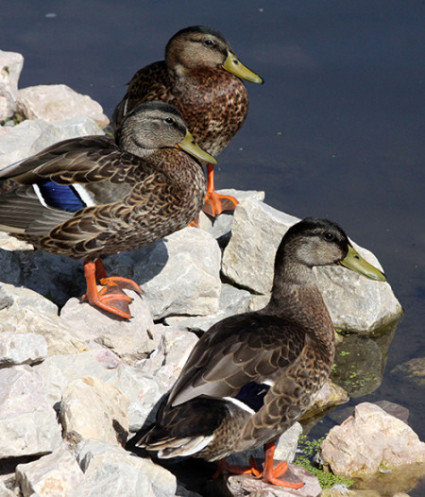
05 Apr Down Items May Not Be Humanely Sourced; Should You Still Buy Them?

Although down purists will say there’s no substitute yet for the real thing, it’s very hard to know whether live plucking was used to make your parka by just looking at the final, manufactured product. ©Draconiansleet, flickr
As one who loves the outdoors and adventure, you most likely have at least one favorite down-filled item: a bone- and soul-warming parka or a guaranteed, dream-inducing sleeping bag no matter where you drop for the night. Such pieces may have been with you for years, and you probably don’t see the need to swap them out for anything newer since nothing yet, in your opinion, has risen to the challenge of replacing real down stuffing.
Down comes from the feathers closest to a bird’s skin, the soft layer primarily in the chest region. This fluffy undercoating provides warmth for ducks, geese and other waterfowl. It is highly valued by manufacturers of outdoor clothing and comforters because down has no quills—the hollow shafts found in regular feathers. Down provides warmth by trapping thousands of tiny air pockets, yet it is breathable, allowing unwanted moisture to escape.
But while your warm down jacket and bedding might bring extreme comfort to you, what you probably don’t realize is that it may have been the cause of much pain and suffering for birds. Unfortunately, there’s no definitive way— yet, at least—to know.
The dark side of down
In most cases, it’s probable that the down in your outdoor gear has been removed from birds after they have been slaughtered. In others, however, those feathers that fill our favored warm garments are taken by a painful and harmful process while the birds are still alive.
According to People for the Ethical Treatment of Animals (PETA), removal of down from live birds involves lifting them by their necks or delicate wings, physically restraining or tying their legs and ripping their feathers out of their skins. The struggling birds are often plucked so hard that their flesh is torn open. When that happens, rushed workers sew up the wounds on the birds using needle and thread—without benefit of anesthesia. Plucking may begin when the animals are just 10 weeks old and be repeated in six-week intervals until the birds are slaughtered for meat.
To make matters worse, these same geese are often being raised for foie gras, which means they’re force-fed several times a day through a pipe that’s shoved down their throats to create what are essentially diseased livers that are up to 10 times their normal size.
Globally, the down industry includes everything from Chinese factory operations to subsistence farms in Hungary, some of which raise the animals primarily for meat but live-pluck them to boost profits. Since down and feathers represent roughly only 10 percent of the value of these birds, the main production areas are China, Hungary, Poland and Ukraine, where duck and goose meat are popular menu items.
The farmers then sell the feathers (mostly from geese, but some from ducks) to a handful of suppliers, who in turn sell them to outdoor companies. Feathers from two geese will create one, heavy winter parka, but it takes the down from 12 to make a king-size comforter.
Then why, with the potential for such cruelty and with synthetic fillings available, is there still a huge market for down?
According to the Down Association of Canada, the natural product gives approximately three times the warmth per ounce as synthetics. No man-made fiber matches down’s warmth-to-weight ratio. Down retains its shape and loft—even after being highly compressed—extremely well. With proper care, it can last for decades, longevity few synthetics can beat.
The bright light of new standards
Recently, however, both The North Face and Patagonia have changed how they source their down, introducing new standards to ensure that the stuffing they use in their products comes from humanely treated geese.
In 2014, Patagonia came out with its Traceable Down Standard. The company (along with Fjällräven) now goes directly to a small set of producers to make sure that 100 percent of their down comes from geese that get adequate food and water, have lots of space to feed and to lay eggs, aren’t force-fed and are plucked only after they’ve been slaughtered.
Last August, The North Face, along with the nonprofit Textile Exchange, released its Responsible Down Standard (RDS), which contains similar requirements. During 2015, however, only 30 percent of The North Face’s products will contain clean down. The company, which manufactures on a large scale, simply can’t get enough down to meet demand. The North Face says by 2017, however, it will reach 100 percent clean down. Eddie Bauer and Marmot have also signed on with RDS.
Another hopeful sign is that two decades ago, down was clearly the better option. But as technology has improved, synthetic filling has made significant headway. High-tech fabrics (such as PrimaLoft or Polarguard), hypoallergenic synthetic down and polyester fill stay warm even when they get wet. Apparel and gear filled with synthetic insulation is also cheaper than that filled with down and can be washed and dried at home with normal detergents.
Will bison provide the next generation of “down”?
Some down purists will tell you that nothing that we’ve created so far can improve on nature. No synthetic has yet matched down’s high quality. But they are looking at a brand-new natural source: bison “down” from the fibers that can be combed from the animals’ insulating undercoats.
However, can we be any surer than we are with geese and ducks that this new source of down will always be collected without cruelty?
In the meantime, since it’s very hard to know whether live plucking was used from looking at the final, manufactured down product, it might be better to eschew all natural filling for synthetics. Then you can hike comfortably and lay your head down under the stars knowing that no duck or goose suffered to make your outdoor adventures possible.
Since, despite the new clean down standards, it may never be possible to know if the down you’re wearing has been collected from humanely treated animals, will you continue to purchase down-filled products? Is down still irreplaceable?
Here’s to your adventures, in whatever corner of the world you find them,
Candy
Latest posts by Candice Gaukel Andrews (see all)
- 10 Reasons Why a Dose of Fear Is Good for You - December 13, 2017
- Extinction Tourism: Seeing Wild Animals Before They’re Gone - November 8, 2017
- The Travel Cycle’s Four Stages—Plus One - October 18, 2017






No Comments